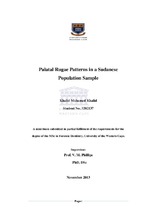| dc.description.abstract | Palatal Rugae Patterns in a Sudanese Population Sample Palatal rugae are ridges resulted from symmetrical and irregular mucosal folds of tissue and located in the alveolar third of the palate. Palatal rugae identification can have a significant role in forensic identification where it is difficult to use the normal identification methods. The aim of this study is to identify and compare the palatal rugal morphological patterns in a sample of adult males and females of Sudanese population.
Maxillary impression models obtained from 100 subjects (50 males and 50
females) of age group 21 – 23 years, of the dental students of University of
Science and Technology, Sudan. The data were assessed based on the Thomas
and Kotze classification (1983) for the length, shape and prevalence. The
Independent - t - Test was used for the statistical analysis. Ethical approvals
declared from the University of Science and Technology, Sudan and University
of the Western Cape South, South Africa to conduct the study. Statistical analysis showed that females had significantly more number of total rugae on the right side of the palate than in males. The prevalence of the palatine rugae numbers was significantly more in females than in males. Primary rugae were distributed more significantly in females more than males. On the right side of the palate, the straight type of rugae was significantly predominant in females than in males whilst the wavy shape was more in males than in females. On the left side of the palate, the curved type of rugae was significantly more presented in males than in females whilst the diverging unification type was more in females than in males. The distribution of number of rugae shapes in both males and females were seen as straight followed by wavy and least was the circular. The total number of straight rugae was significantly more in females than in males, as well as circular rugae and diverging rugae. In contrast, curved rugae were significantly more in males than in females. There were 11 individuals who did not comply with the Thomas and Kotze classification thus was recorded as unspecified. Page iv This Sudanese study showed significant differences between males and females in the number, length and shapes of rugae. Hence, the individuality and uniqueness of palatine rugae can be used as a tool for forensic dental identification, and possibly distinction between males and females. There is also a possibility that there are ethnic differences in rugal patterns. | en_US |

